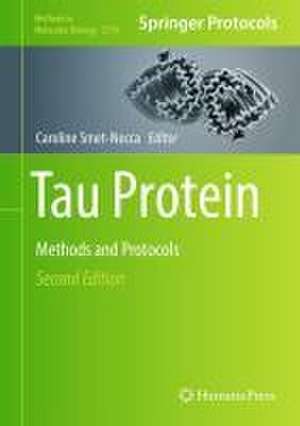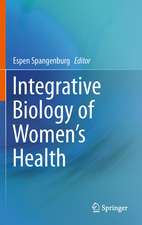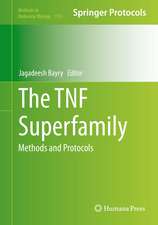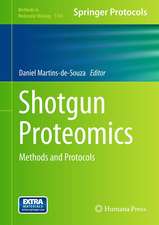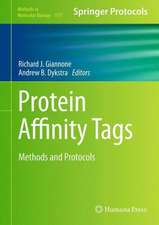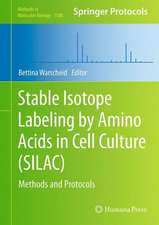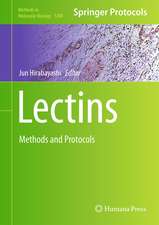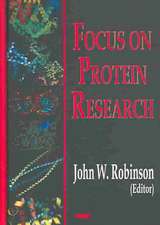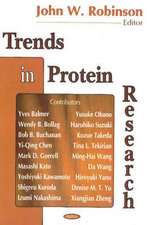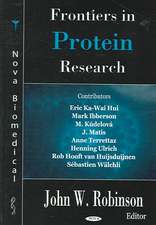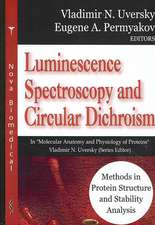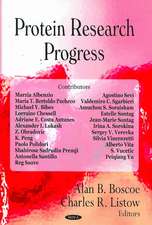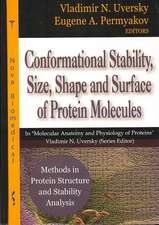Tau Protein: Methods and Protocols : Methods in Molecular Biology, cartea 2754
Editat de Caroline Smet-Noccaen Limba Engleză Hardback – 22 mar 2024
This volume explores the latest advancements and techniques to study Tau protein that include basic and advanced methods and protocols from in vitro assays to in vivo models that address the molecular and functional aspects of tau physiopathology and many of its related technical issues. The chapters in this book are organized into five parts: Part One describes conformational and functional studies of native tau protein using wet and non-wet lab protocols. Part Two looks at in vitro methods to monitor or control the formation of Tau oligomers and fibrils, and the fibrillization process. Part Three provides protocols for the characterization and in vitro introduction of post-translational modifications in Tau protein for further functional studies. Part Four describes analytical tools for the detection of Tau proteins under various forms, factors associated with Tau pathology, and MAPT gene studies. Finally, Part Five explores cellular and in vivo models for the investigations of Tau physiopathology. Written in the highly successful Methods in Molecular Biology series format, chapters include introductions to their respective topics, lists of the necessary materials and reagents, step-by-step, readily reproducible laboratory protocols, and tips on troubleshooting and avoiding known pitfalls.
Cutting-edge and comprehensive, Tau Proteins: Methods and Protocols, Second Edition is a valuable tool for any researcher interested in learning more about this important and developing field related to Tau protein as a relevant and attractive target for neurodegeneration therapies.
| Toate formatele și edițiile | Preț | Express |
|---|---|---|
| Paperback (1) | 596.20 lei 38-44 zile | |
| Springer – 7 iul 2018 | 596.20 lei 38-44 zile | |
| Hardback (2) | 824.52 lei 38-44 zile | |
| Springer – 14 dec 2016 | 824.52 lei 38-44 zile | |
| Springer Us – 22 mar 2024 | 1410.63 lei 6-8 săpt. |
Din seria Methods in Molecular Biology
- 9%
 Preț: 791.63 lei
Preț: 791.63 lei - 23%
 Preț: 598.58 lei
Preț: 598.58 lei - 20%
 Preț: 882.98 lei
Preț: 882.98 lei -
 Preț: 252.05 lei
Preț: 252.05 lei - 5%
 Preț: 802.70 lei
Preț: 802.70 lei - 5%
 Preț: 729.61 lei
Preț: 729.61 lei - 5%
 Preț: 731.43 lei
Preț: 731.43 lei - 5%
 Preț: 741.30 lei
Preț: 741.30 lei - 5%
 Preț: 747.16 lei
Preț: 747.16 lei - 15%
 Preț: 663.45 lei
Preț: 663.45 lei - 18%
 Preț: 1025.34 lei
Preț: 1025.34 lei - 5%
 Preț: 734.57 lei
Preț: 734.57 lei - 18%
 Preț: 914.20 lei
Preț: 914.20 lei - 15%
 Preț: 664.61 lei
Preț: 664.61 lei - 15%
 Preț: 654.12 lei
Preț: 654.12 lei - 18%
 Preț: 1414.74 lei
Preț: 1414.74 lei - 5%
 Preț: 742.60 lei
Preț: 742.60 lei - 20%
 Preț: 821.65 lei
Preț: 821.65 lei - 18%
 Preț: 972.30 lei
Preț: 972.30 lei - 15%
 Preț: 660.49 lei
Preț: 660.49 lei - 5%
 Preț: 738.41 lei
Preț: 738.41 lei - 18%
 Preț: 984.92 lei
Preț: 984.92 lei - 5%
 Preț: 733.29 lei
Preț: 733.29 lei -
 Preț: 392.60 lei
Preț: 392.60 lei - 5%
 Preț: 746.26 lei
Preț: 746.26 lei - 18%
 Preț: 962.66 lei
Preț: 962.66 lei - 23%
 Preț: 860.22 lei
Preț: 860.22 lei - 15%
 Preț: 652.64 lei
Preț: 652.64 lei - 5%
 Preț: 1055.50 lei
Preț: 1055.50 lei - 23%
 Preț: 883.87 lei
Preț: 883.87 lei - 19%
 Preț: 491.89 lei
Preț: 491.89 lei - 5%
 Preț: 1038.86 lei
Preț: 1038.86 lei - 5%
 Preț: 524.16 lei
Preț: 524.16 lei - 18%
 Preț: 2122.34 lei
Preț: 2122.34 lei - 5%
 Preț: 1299.23 lei
Preț: 1299.23 lei - 5%
 Preț: 1339.12 lei
Preț: 1339.12 lei - 18%
 Preț: 1390.26 lei
Preț: 1390.26 lei - 18%
 Preț: 1395.63 lei
Preț: 1395.63 lei - 18%
 Preț: 1129.65 lei
Preț: 1129.65 lei - 18%
 Preț: 1408.26 lei
Preț: 1408.26 lei - 18%
 Preț: 1124.92 lei
Preț: 1124.92 lei - 18%
 Preț: 966.27 lei
Preț: 966.27 lei - 5%
 Preț: 1299.99 lei
Preț: 1299.99 lei - 5%
 Preț: 1108.51 lei
Preț: 1108.51 lei - 5%
 Preț: 983.76 lei
Preț: 983.76 lei - 5%
 Preț: 728.16 lei
Preț: 728.16 lei - 18%
 Preț: 1118.62 lei
Preț: 1118.62 lei - 18%
 Preț: 955.25 lei
Preț: 955.25 lei - 5%
 Preț: 1035.62 lei
Preț: 1035.62 lei - 18%
 Preț: 1400.35 lei
Preț: 1400.35 lei
Preț: 1410.63 lei
Preț vechi: 1720.28 lei
-18% Nou
Puncte Express: 2116
Preț estimativ în valută:
269.96€ • 280.80$ • 222.87£
269.96€ • 280.80$ • 222.87£
Carte tipărită la comandă
Livrare economică 14-28 aprilie
Preluare comenzi: 021 569.72.76
Specificații
ISBN-13: 9781071636282
ISBN-10: 1071636286
Ilustrații: XVIII, 608 p. 1 illus.
Dimensiuni: 178 x 254 mm
Greutate: 1.29 kg
Ediția:2nd ed. 2024
Editura: Springer Us
Colecția Humana
Seria Methods in Molecular Biology
Locul publicării:New York, NY, United States
ISBN-10: 1071636286
Ilustrații: XVIII, 608 p. 1 illus.
Dimensiuni: 178 x 254 mm
Greutate: 1.29 kg
Ediția:2nd ed. 2024
Editura: Springer Us
Colecția Humana
Seria Methods in Molecular Biology
Locul publicării:New York, NY, United States
Cuprins
Characterization of Post-Translationally Modified PHF-1 Tau Peptides using Gaussian Accelerated Molecular Dynamics Simulation.- Interaction of Tau with G-Protein Coupled Purinergic P2Y12 Receptor by Molecular Docking and Molecular Dynamic Simulation.- Structural Flexibility of Tau in its Interaction with Microtubules as Viewed by Site-Directed Spin Labelling EPR Spectrocopy.- Cryo-Electron Microscopy and Molecular Modelling Methods to Characterize the Dynamics of Tau-Bound to Microtubules.- Assays for the Screening and Characterization of Tau Aggregation Inhibitors.- Photo-Excited Dyes: Emerging Technique Against Tau Protein Aggregation.- Sedimentation and Laser Light Scattering Methods for Quantifying Synthetic Tau Aggregation Propensity.- Recombinant Production and Characterization of VHHs/Nanobodies Targeting Tau to Block Fibrillar Assembly.- Tau Oligomers as Pathogenic Seeds: Preparation, Characterization, and Propagation In Vitro and InVivo.- Preparation of Tau Condensates by Liquid-Liquid Phase Separation to Study Tau Amyloid Aggregation.- Biochemical and Biophysical Characterization of Tau and α-Linolenic Acid Vesicles In Vitro.- Detection of Small-Molecule Interactions with Fibrillar Tau Protein Aggregates Using Microscale Thermophoresis.- Quantification of Methylation and Phosphorylation Stoichiometry.- The O-GlcNAc Modification of Recombinant Tau Protein and Characterization of the O-GlcNAc Pattern for Functional Study.- Phosphorylation of Tau Protein by CDK2/cyclin A and GSK3β Recombinant Kinases: Analysis of Phosphorylation Patterns by Nuclear Magnetic Resonance Spectroscopy.- Western Blot of Tau Protein from Mouse Brains Extracts: How to Avoid Signal Artifacts.- Methods for Biochemical Isolation of Insoluble Tau in Rodent Models of Tauopathies.- A Method to Collect Cerebrospinal Fluid from Mouse Cisterna Magna to Determine Extracellular Tau Levels.- Detectionof Glymphatic Outflow of Tau from Brain to Cerebrospinal Fluid in Mice.- Differential Regulation of Neurotrophic Factors during Pathogenic Tau-Aggregation in a Tau Transgenic Mouse Model for Alzheimer’s Disease: A Protocol for Double-Labeling mRNA by In Situ Hybridization and Protein Epitopes by Immunohistochemistry.- Intranasal Nose-to-Brain Drug Delivery Via the Olfactory Region in Mice: Two In-Depth Protocols for Region-Specific Intranasal Application of Antibodies and for Expression Analysis of Fc Receptors Via In Situ Hybridization in the Nasal Mucosa.- Detecting and Validating MAPT Mutations in Neurodegeneration Patients and Analysis of Exon Splicing Consequences.- Measuring Antibody-Mediated Tau Fibril Uptake in Microglia by Flow Cytometry.- Super-Resolution Imaging of Tau Proteins in Isolated and Immobilized Brain Synaptosomes.- Purinergic Receptor P2Y12-Mediated Tau Internalization in Microglia.- Alpha-Linolenic Acid Induces Microglial Activation and Extracellular Tau Internalization.- Identification of Tau Toxicity Modifiers in the Drosophila Eye.- Tracking Tau in Neurons: How to Transfect and Track Exogenous Tau in Primary Neurons.- Tracking Tau in Neurons: How to Grow, Fix, and Stain Primary Neurons for the Investigation of Tau in All Developmental Stages.- Differentiating SH-SY5Y Cells into Polarized Human Neurons for Studying Endogenous and Exogenous Tau Trafficking: Four Protocols to Obtain Neurons with Noradrenergic, Dopaminergic, and Cholinergic Properties.- Cultivation, Differentiation, and Lentiviral Transduction of Human Induced Pluripotent Stem Cell (hiPSC)-Derived Glutamatergic Neurons for Studying Human Tau.- Optimized Calcium-Phosphate Based Co-Transfection of Tau and tdTomato into Human iPSC-Derived Neurons for the Study of Intracellular Distribution of Wildtype and Mutant Human Tau.- Studying Microtubule Dynamics in Human Neurons: 2D Microtubule Tracing and Kymographs iniPSC- and SH-SY5Y-Derived Neurons for Tau Research.- A Brain Ischemia-Reperfusion Model for the Study of Tau Phosphorylation and O-GlcNAcylation.
Textul de pe ultima copertă
This volume explores the latest advancements and techniques to study Tau protein that include basic and advanced methods and protocols from in vitro assays to in vivo models that address the molecular and functional aspects of tau physiopathology and many of its related technical issues. The chapters in this book are organized into five parts: Part One describes conformational and functional studies of native tau protein using wet and non-wet lab protocols. Part Two looks at in vitro methods to monitor or control the formation of Tau oligomers and fibrils, and the fibrillization process. Part Three provides protocols for the characterization and in vitro introduction of post-translational modifications in Tau protein for further functional studies. Part Four describes analytical tools for the detection of Tau proteins under various forms, factors associated with Tau pathology, and MAPT gene studies. Finally, Part Five explores cellular and in vivo models for the investigations of Tau physiopathology. Written in the highly successful Methods in Molecular Biology series format, chapters include introductions to their respective topics, lists of the necessary materials and reagents, step-by-step, readily reproducible laboratory protocols, and tips on troubleshooting and avoiding known pitfalls.
Cutting-edge and comprehensive, Tau Proteins: Methods and Protocols, Second Edition is a valuable tool for any researcher interested in learning more about this important and developing field related to Tau protein as a relevant and attractive target for neurodegeneration therapies.
Caracteristici
Includes cutting-edge methods and protocols Provides step-by-step detail essential for reproducible results Contains key notes and implementation advice from the experts
